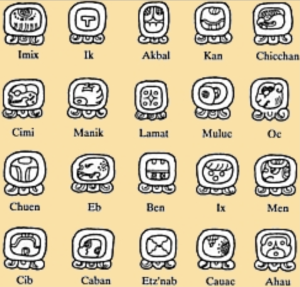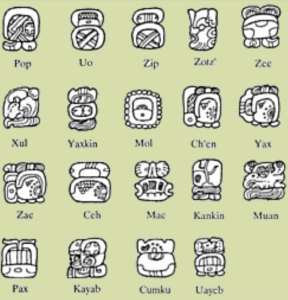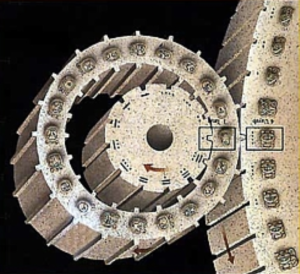About the measurement of time
 Given that the Mayan astronomical achievements have a perfect basis in human capabilities, we are in the presence of a culture noted for its perseverance and observational rigor, but like many other cultures, it gave celestial observation a religious character and a source of omens. (in our jargon, homogeneity between astronomy and astrology), associating certain celestial events (e.g. eclipses) as a predictor of wars, harvest times or the need for human sacrifices to satisfy the gods. All of this mythology acted as the basis for one of the most famous achievements of the Mayan culture: their calendar.
Given that the Mayan astronomical achievements have a perfect basis in human capabilities, we are in the presence of a culture noted for its perseverance and observational rigor, but like many other cultures, it gave celestial observation a religious character and a source of omens. (in our jargon, homogeneity between astronomy and astrology), associating certain celestial events (e.g. eclipses) as a predictor of wars, harvest times or the need for human sacrifices to satisfy the gods. All of this mythology acted as the basis for one of the most famous achievements of the Mayan culture: their calendar.
 The Mayan calendar has the curiosity of being made up of two different "counts" of days that occur simultaneously. Tzolkin, 260 days and Haab, 365 days, in addition to a Long Count uninterrupted, starting from August 11, 3114 BC Within the complex calendrical counting system, the Mayans merged the Tzolkin (presumably based on the cycles of Venus) with the Haab (which describes a common sidereal year) in an instrument called Calendar Wheel, consisting of 3 concentric circles that result in a total of 18,890 cyclic days, where one of the days of the Tzolkin count coincides with one of the days of the Haab count; Likewise, the cycle of 18,890 days is equivalent to 73 Tzolkin cycles and 52 Haab cycles.
The Mayan calendar has the curiosity of being made up of two different "counts" of days that occur simultaneously. Tzolkin, 260 days and Haab, 365 days, in addition to a Long Count uninterrupted, starting from August 11, 3114 BC Within the complex calendrical counting system, the Mayans merged the Tzolkin (presumably based on the cycles of Venus) with the Haab (which describes a common sidereal year) in an instrument called Calendar Wheel, consisting of 3 concentric circles that result in a total of 18,890 cyclic days, where one of the days of the Tzolkin count coincides with one of the days of the Haab count; Likewise, the cycle of 18,890 days is equivalent to 73 Tzolkin cycles and 52 Haab cycles.
The uninterrupted computing system of the Long Count, which contains more elementary units of time that I will not go into further (tunes, katunes, baktunes, etc.) and has a vigesimal base, results in measurements ordered in a XXXXX syntax (e.g. 8.5.16.9.7, equivalent to July 14, 156 AD, according to the Gregorian calendar).
 Since baktuns are the highest combinable time unit (144,000 days), the maximum possible configuration for each cycle is X.0.0.0.0 (e.g. 2.0.0.0.0, 3.0.0.0.0, etc.), where It turns out that 13.0.0.0.0 is equivalent to the fourteenth baktun and, within Mayan mythology, the beginning of a new creation, our entry into the sixth world (until now we would be living in the fifth) and the return of the god Quetzalcoatl. The date that corresponds to 13.0.0.0.0, in this context, is the December 21, 2012. But what does this mean, exactly? Simply the transition from an old cycle to a new one, in a strictly calendar framework, just as for contemporary society, January 1 is our entrance to a new cycle that comes from an old one - December 31 -. However, the mere fact that 12/21/2012 coincides with this new series of 144,000 days and the associated mythology, has been a source of crazy ideas about an apocalypse.
Since baktuns are the highest combinable time unit (144,000 days), the maximum possible configuration for each cycle is X.0.0.0.0 (e.g. 2.0.0.0.0, 3.0.0.0.0, etc.), where It turns out that 13.0.0.0.0 is equivalent to the fourteenth baktun and, within Mayan mythology, the beginning of a new creation, our entry into the sixth world (until now we would be living in the fifth) and the return of the god Quetzalcoatl. The date that corresponds to 13.0.0.0.0, in this context, is the December 21, 2012. But what does this mean, exactly? Simply the transition from an old cycle to a new one, in a strictly calendar framework, just as for contemporary society, January 1 is our entrance to a new cycle that comes from an old one - December 31 -. However, the mere fact that 12/21/2012 coincides with this new series of 144,000 days and the associated mythology, has been a source of crazy ideas about an apocalypse.
About the supposed Mayan prophecies
1) The Mayans NEVER They associated 13.0.0.0.0 (12/21/2012) with an apocalyptic catastrophe. Except for its mythological significance and cyclical nature of the date, there is no archaeological record to prove such a statement. I support this in a special statement posted on the website FAMSI (Foundation for the Advancement of the Mesoamerican Studies), which includes 4 excellent PDF documents explaining the real meaning of the Mayan calendars.
2) The Mayan prophecies NO They do exist, they are not recorded in any codex. They are an invention originating from a 1999 TV show called "The Owners of Time. The Seven Mayan Prophecies", produced by architect Fernando Malkún. Not only was nothing known about the alleged prophecies before this program, but they contradict the Mayan worldview itself, as documented by serious research. I support this with an excellent critical analysis which exposes the deliberate prophetic creation by F. Malkún.
 3) The Mayan time measurement system NO ends in the syntax 13.0.0.0.0. The most used units of computation were the Kin, Uinal, Tun and Baktún (see figure), but there were also others such as the Piktún, which is equivalent to 20 baktuns (1 piktún = 2,880,000 days/7,890 years) or the kalabtún, which is equivalent to 20 piktunes (1 kalabtun = 57,600,000 days/157,808 years), of which brief records were found, on dates later to 2012. For example, the coronation of Pakal (King of Palenque) appears connected to an event that occurs in the year 4,772 AD, equivalent to the syntax 1.0.0.0.0.8 (according to Dr. Mark Van Stone of FAMSI, in A look at the Creation, p.95); From this it follows that 13.0.0.0.0 is not the end of the complete calendar cycle that restarts at 1.0.0.0.0, but only the end of a baktun, which will be followed by 14.0.0.0.0, 15.0.0.0.0 and so on until 20.0.0.0.0, since the Piktún unit includes 20 baktuns.
3) The Mayan time measurement system NO ends in the syntax 13.0.0.0.0. The most used units of computation were the Kin, Uinal, Tun and Baktún (see figure), but there were also others such as the Piktún, which is equivalent to 20 baktuns (1 piktún = 2,880,000 days/7,890 years) or the kalabtún, which is equivalent to 20 piktunes (1 kalabtun = 57,600,000 days/157,808 years), of which brief records were found, on dates later to 2012. For example, the coronation of Pakal (King of Palenque) appears connected to an event that occurs in the year 4,772 AD, equivalent to the syntax 1.0.0.0.0.8 (according to Dr. Mark Van Stone of FAMSI, in A look at the Creation, p.95); From this it follows that 13.0.0.0.0 is not the end of the complete calendar cycle that restarts at 1.0.0.0.0, but only the end of a baktun, which will be followed by 14.0.0.0.0, 15.0.0.0.0 and so on until 20.0.0.0.0, since the Piktún unit includes 20 baktuns.
Apocalyptic scenarios
Despite the strong evidence that confirms both the feasibility of the Mayan astronomical achievements, as well as the nonexistence of prophecies or apocalyptic significance of the syntax 13.0.0.0.0 (12/21/2012), various catastrophic scenarios that could occur have been attributed. . Seeing the Mayan background in the background, I only want to explain the most important and well-known ones:

